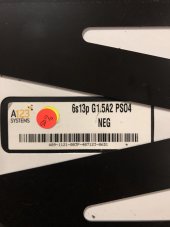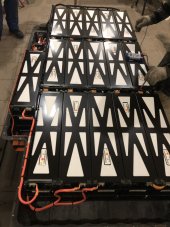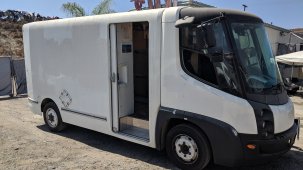aquicklook
New Member
- Joined
- Sep 27, 2021
- Messages
- 6
So, a few years ago FedEx was auctioning off a bunch of their 2011 Estar fleet vans, and I bought several. I sold a few nice ones, but two were too far gone, so I ended up with two 80kWh battery packs.
Here are the specs: A123 Systems, LiFePO4. Each pack has 16 modules. Each module is a 6s13p, for a nominal voltage of around 20V and capacity of 260 Ah or 5 kWh. Each module weighs about 100 lbs.
So I have a total of 160 kWh available in (thirty two) 5 kWh 20V configurable chunks.
I also have 75 kW of solar panels ready to be deployed ground mount.
I live on 100 acres in rural AZ, no shade or trees.
The idea is to eliminate the $400 electric bill and $250 monthly propane consumption, and convert the house to fully electric and shut the utility main breaker off forever. And go off-grid.
We own 2 EVs.
The size of the system is intentionally larger than needed today, with plans on going even larger in the future. Any excess production could be utilized on Bitcoin mining, while also heat the house in the winter.
My questions are:
What voltage should I build my battery? I can go 60V, or 600V, or anything in between. Batteries and components will probably be housed in a dedicated shed away from the house, due to high voltage danger. I am still debating on that.
What off-grid inverter would be the most value for the money? For the start, I'd want a 20kW inverter, but need to be able to grow that number to 50kW or more.
What MPPT charger can even take this many kW in?
For BMS, I am familiar with JK BMS. Although it's only going up to 24 cells, I can use several in series, and cell data can be output to the screens.
Here are the specs: A123 Systems, LiFePO4. Each pack has 16 modules. Each module is a 6s13p, for a nominal voltage of around 20V and capacity of 260 Ah or 5 kWh. Each module weighs about 100 lbs.
So I have a total of 160 kWh available in (thirty two) 5 kWh 20V configurable chunks.
I also have 75 kW of solar panels ready to be deployed ground mount.
I live on 100 acres in rural AZ, no shade or trees.
The idea is to eliminate the $400 electric bill and $250 monthly propane consumption, and convert the house to fully electric and shut the utility main breaker off forever. And go off-grid.
We own 2 EVs.
The size of the system is intentionally larger than needed today, with plans on going even larger in the future. Any excess production could be utilized on Bitcoin mining, while also heat the house in the winter.
My questions are:
What voltage should I build my battery? I can go 60V, or 600V, or anything in between. Batteries and components will probably be housed in a dedicated shed away from the house, due to high voltage danger. I am still debating on that.
What off-grid inverter would be the most value for the money? For the start, I'd want a 20kW inverter, but need to be able to grow that number to 50kW or more.
What MPPT charger can even take this many kW in?
For BMS, I am familiar with JK BMS. Although it's only going up to 24 cells, I can use several in series, and cell data can be output to the screens.





